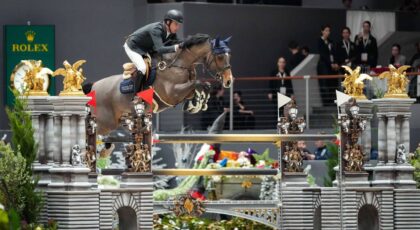If you’re like most riders, you’ve spent hours compiling data on your horse.
You’ve recorded his daily diet and planned for the strategic introduction of supplements. You’ve pre-mapped his training regime for the year and tracked weekly changes in his fitness. You’ve logged his faults in the ring, recorded the type of fence they incurred at and made note of both the offending foot and lead. You’ve probably even—
Just kidding.
While horse people are often phenomenal organizers, most spend more time recording their vet bills than the number of minutes they spent trotting on a given day.
Sport scientist Dr. Tim Worden, however, is not most people.
A biomechanics PhD, he’s worked alongside Olympic and international show jumpers to track and analyze sport specific data in order to improve athletic performance.
“I’ve been very lucky to work with some very good riders over the years and to track a lot of really interesting information,” said the Toronto-based scientist. “One of things we’ve noted, when we analyzed hundreds of rounds of top show jumping horses, is that there seems to be an asymmetry between the number of rails they have off the left or the right lead.
“In general, they have about 15% more rails off the left lead than the right lead.”
But that’s just the tip of this fault-inducing iceberg.
Dr. Worden’s research reveals that the lead-fault anomaly is specific to certain show jumping situations.
“When you did a little deeper into their faults, this asymmetry only shows up on straighter approaches,” he explained.
“So, when a horse is going straight at jump, off a gradual turn, maybe in a bending line, you’ll see more faults off the left versus right lead. But as soon as you start turning shorter on a roll back, or maybe a medium turn, that asymmetry disappears and then the number of faults off the left and right lead are 50/50 again.”
So why does this asymmetry exist in the first place? The good doctor has a few theories:
“I’ve asked a number of experts in the field, a number of trainers, veterinarians, therapists, why they think this asymmetry may show up. Some people hypothesized that horses, like humans, have eye dominance. So, there may just be an inherent eye dominance that causes a horse to twist its head a little more [in one direction] to focus on a jump and that may throw the body off as it approaches the jump and cause it not to jump as accurately off the left lead.”
Another hypothesis is that the asymmetry is caused by the rider.
“Most riders are right handed, so maybe through training that biases the horse to be a bit more supple off the right lead, which caused it to be a little less consistent jumping off the left lead,” he proposed.
It’s also possible, he said, that horses may have lead dominance. Just as a human is right- or left-hand dominant, a horse might be left- or the right lead dominant and, if so, this dominance may show up more prominently in European horses.
“When you watch a lot of the schooling rings in Europe, they tend to only go in one direction because the rings are so small, so that may also factor in to the horse spending more time on the left lead, which creates some asymmetry that could cause more rails off that left lead,” he elaborated.
While Dr. Worden’s research is specific to elite show jumpers, it’s reasonable to expect that similar results would be seen in amateur athletes.
But, you’ll have to start tracking the data on your horse to find out!




 February 20, 2018
February 20, 2018 































